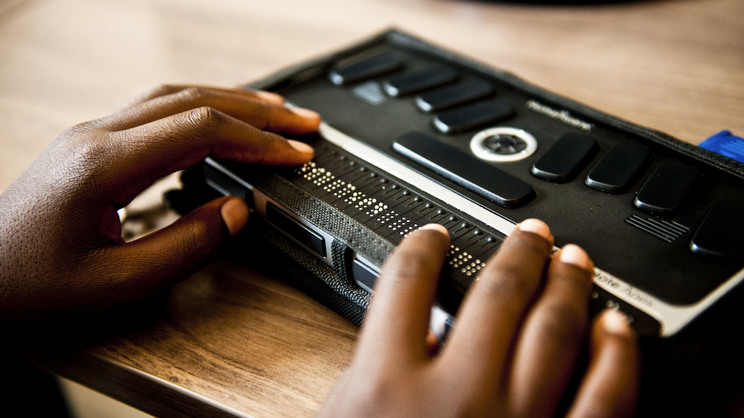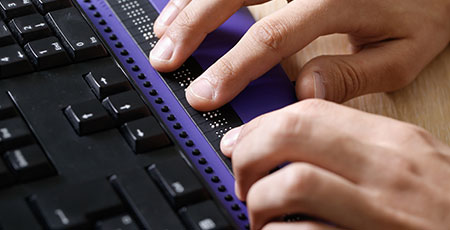Mobility Aids for Visually Impaired Users: Navigating the World with Confidence
Mobility Aids for Visually Impaired Users: Navigating the World with Confidence
Blog Article
Empowering Freedom With Assistive Innovation for the Blind
The combination of assistive technology into the lives of individuals with visual impairments stands for a considerable development in advertising freedom and self-sufficiency. From innovative screen readers to advanced smart canes, these tools not only boost day-to-day navigation and communication yet also encourage customers to involve meaningfully in different facets of life. As we check out the myriad advantages and real-world applications of these innovations, it ends up being important to examine the underlying variables that add to their effectiveness and the possibility for future developments in this essential field.
Review of Assistive Technology

The development of assistive modern technology is based in principles of inclusivity and empowerment. Developments in software application, equipment, and sensory improvements give customers with alternatives tailored to their particular needs. From screen readers that transform message to speech, to tactile devices that share information through touch, these devices change the method individuals engage with their surroundings.
Along with functional applications, assistive innovation cultivates greater social addition and participation in numerous sectors, including education and employment (Voice-activated assistive devices). As r & d continue to advance, the capacity for assistive modern technology to even more boost the lives of visually damaged individuals stays promising, leading the method for a much more fair society where every person can flourish
Kinds of Assistive Tools
A selection of assistive devices have actually emerged to sustain people with visual impairments, each made to fulfill certain demands and boost day-to-day performance. These gadgets vary from low-tech remedies to high-tech developments, giving varied choices for customers.
Low-tech tools include magnifiers and large-print materials that aid in reading and writing. Braille devices, such as Braille styluses and slates, make it possible for tactile analysis and communication. Alignment and wheelchair help, like white walking canes, help users browse their environment securely.
On the greater end of the spectrum, electronic magnification systems and screen viewers offer substantial support. Digital magnifiers allow users to expand message and photos on screens, while screen visitors transform electronic web content right into manufactured speech, assisting in accessibility to details on computers and mobile phones.
Smartphone applications likewise play a critical duty, giving attributes like text acknowledgment and navigation assistance. Wearable technology, such as smart glasses outfitted with enhanced reality, is becoming a promising tool to enhance situational awareness.
Advantages of Assistive Technology
The integration of assistive modern technology significantly enhances the lifestyle for individuals with visual problems. These technologies equip customers by advertising self-reliance, allowing them to navigate their environments more effectively and do day-to-day jobs with higher simplicity. Screen viewers and magnifying software application permit individuals to accessibility digital info, fostering professional and academic possibilities that may have previously been out of reach.
In addition, assistive tools such as clever walking sticks and general practitioners applications give real-time navigating assistance, boosting mobility and security. This raised freedom not just improves self-esteem however additionally view website urges social involvement, permitting users to participate more fully in their communities.
Assistive technology additionally facilitates communication, aiding customers get in touch with others with voice acknowledgment and text-to-speech applications. This capability is crucial for preserving relationships and accessing essential info.
In addition, the modification alternatives readily available with lots of assistive modern technologies ensure that users can tailor tools to their specific demands, better boosting usability and effectiveness. Overall, the benefits of assistive innovation for people with visual impairments are profound, advertising an extra comprehensive society where everyone can seek their objectives find more info and aspirations.
Instance Studies and Success Stories
Highlighting the transformative effect of assistive innovation, numerous study show exactly how people with aesthetic problems have successfully integrated these devices into their everyday lives. One compelling example entails an university pupil who made use of screen reading software program to navigate academic products and on-line resources properly. This modern technology not just promoted her education yet also improved her confidence in joining discussions and team jobs.
Another instance research study features a specialist that employs a smart device application developed for navigation and item acknowledgment. By utilizing this application, he has restored autonomy in both his personal and workplace, enabling him to commute independently and involve with coworkers better.
In addition, a retired person shared her experience with braille e-readers, which allowed her to access a huge variety of literary works and remain gotten in touch with her neighborhood via publication clubs.
These success tales highlight the important duty of assistive innovation in fostering independence, enhancing top quality of life, and advertising social assimilation for individuals with aesthetic disabilities find out here now (Smart glasses for the visually impaired). By welcoming these innovative devices, individuals can conquer difficulties and seize possibilities that add to their professional and personal gratification

Future Fads in Assistive Technology
Advancement in assistive technology is positioned to redefine the landscape of assistance for individuals with visual impairments. Arising patterns stress the integration of synthetic knowledge (AI) and artificial intelligence, which enhance the performance of devices that aid with navigation and details availability. AI-driven applications are now qualified of translating visual information in real-time, allowing users to involve with their environment a lot more independently.
Additionally, the growth of wearable technology is advancing quickly. Smart glasses furnished with augmented truth (AR) can give audio descriptions of surroundings, transforming just how users communicate with public rooms. These tools not only promote autonomy however additionally foster social incorporation.
In Addition, the Web of Things (IoT) is making homes smarter, enabling seamless connectivity between day-to-day appliances and assistive tools. This connection equips individuals by enabling voice-activated controls and automated reactions customized to specific needs.
Verdict
In verdict, assistive modern technology plays a pivotal role in empowering people with aesthetic disabilities by enhancing their self-reliance and interaction with their environments. The diverse series of devices and applications readily available not just assists in navigating and communication however additionally promotes social combination and possibilities for individual and expert development. As innovations continue in this area, the potential for enhancing the lifestyle for those with aesthetic disabilities will expand, fostering higher autonomy and empowerment.

Report this page